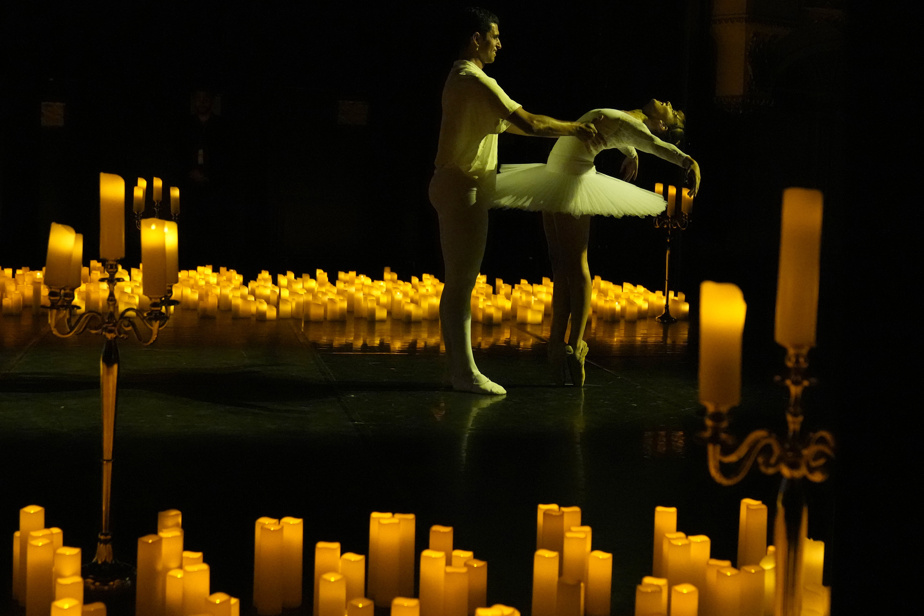(Paris) How to transmit the choreography of a ballet of which there are few written traces of its author? Orally, “from generation to generation” of dancers, and with the support of video, rehearsals and performers respond Nutcrackera major work of the classical repertoire, danced in Paris this month.
“You put your energy almost a little too much ahead”, “your direction, it’s there!” “. On this afternoon at the end of November, Élisabeth Maurin, ballet teacher at the Paris Opera and coach for this ballet, advises two stars, Myriam Ould-Braham and Germain Louvet, who are working on “the grand pas de deux”, in a studio in the Palais Garnier.
In another room, it is the corps de ballet, in tutu, which practices The Snowflake Danceunder the watchful eye of Sabrina Mallem, ballet mistress.
The premiere of this magical classic, which tells the story of a little girl, Clara, receiving a toy that transforms into a prince, takes place in Paris on Monday (the performances on Friday and Sunday are canceled due to a strike). ‘part of the staff at the time of the last rehearsals). The ballet is performed until 1er January.
Designed in Russia in the 19th centurye century by the choreographers Marius Petipa and Lev Ivanov, to music by Tchaikovsky, Nutcracker is regularly danced, in France and elsewhere, in its version created in 1985 at the Paris Opera by Rudolf Nureyev, then director of the ballet (1983-1989).
However, “there is no writing” of his choreography, affirms to AFP Charles Jude, former star dancer, in charge of the artistic part of the Nureyev Foundation. At most “a few traces on the drawings, which above all indicate the architecture of his choreography, but there are no steps”.
“We have a fairly unique practice”, that of “oral transmission”, explains Élisabeth Maurin, between two rehearsals. This former dancer of the institution, who won her star title in 1988 on this ballet precisely, is part of the “Nureyev generation”.
“I base this on what I received, on the fact of having worked on it with the ballet masters appointed to the creation” and of having danced it for “around fifteen years”, she adds .
In turn, Myriam Ould-Braham benefits from her “oral and physical” coaching to interpret Clara, the title role, which she already danced in 2009. “It is a gift to have her in the studio to transmit to us all her knowledge”, she testifies, while the choreography of this ballet can seem “complex”, with “a lot of steps, to little music”.
Video
“This transmission also passes through all the sensations and artistic visions which have been stored by the performers and are given back to us,” estimates Germain Louvet, who plays Uncle Drosselmeyer and the prince.

PHOTO JOEL SAGET, AGENCE FRANCE-PRESSE ARCHIVES
Germain Louvet
Sabrina Mallem, hired by the company in 1998, did not know Nureyev, but learned alongside a star dancer who had worked with him. From him, she retained what makes, according to her, the “Nureyev style”: “very rounded port de bras, very precise positions, impeccable placements”, among others.
It is “a transmission from generation to generation” which allowed him to acquire a “physical memory” of the ballets he worked on.
For dancers and rehearsal teachers, there is an added tool: video. The Opera has numerous audiovisual archives. Elisabeth Maurin watches it to perfect her preparation. Sabrina Mallem studies the versions in “tight shots”, but also in “wide shots”.
Placements of the dancers, counting of the beats of a musical sequence, etc., everything is then recorded in his notes.
“I never tried to change anything, especially not. A pirouette remains a pirouette, a fumble remains a fumble,” she says.
The Foundation also monitors: “each time a Nureyev ballet is reassembled around the world, I take care to find the most appropriate people to remount the work and I go there myself from time to time” , explains Charles Jude.
However, “we are not a museum, we also work with the interpreter we have in front of us,” emphasizes Élisabeth Maurin.
“The choreography is one thing, the interpretation is something else,” says Sabrina Mallem. Each dancer has “his own technique” and “his sensitivity”.
